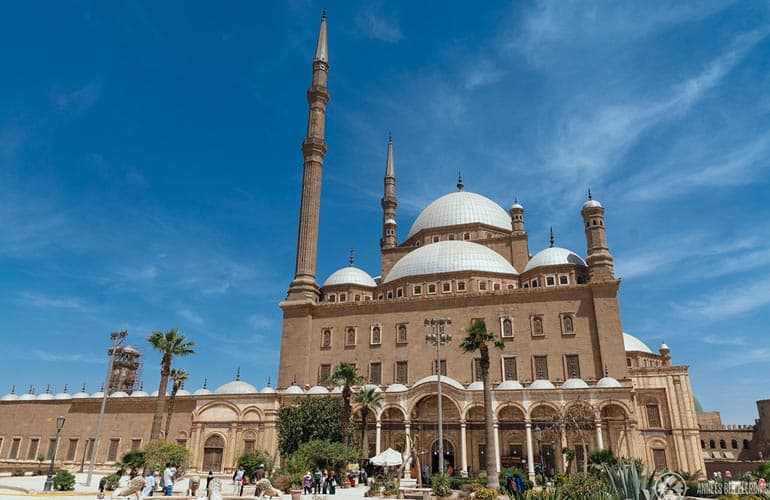Citadel of Saladin is one of the most important medieval fortifications in the world. This impressive military construction of high walls, huge towers, and numerous gates is one of the best things to see and do in the city.

History of the Citadel of Saladin
Al-Nāsir Ṣalāḥ ad-Dīn Yūsuf ibn Ayyūb, known in the West as Saladin, was the first ruler of the Ayyubid dynasty and sultan of Egypt between 1171 and 1193. He abolished Fatimid power and reinstated Sunnism as the official religion when he came to power.
Saladin built this fortress, declared a World Heritage Site, as a royal residence and to protect the city from Crusader attacks. Its effectiveness was such that until the 19th century it was used as the seat of the Egyptian government.
The first thing that was erected was an imposing wall that surrounded both Cairo and Fustat, a nearby city that was the capital of Egypt for 500 years and today is part of Historic Cairo.
To build this wall and its towers, Saladin used the most modern construction techniques of the time. In addition, he devised an 85-meter deep well, called the Well of Yusuf, which was dug into the rock, and a system of aqueducts that transported water throughout the city.

The mosque is divided into two sections:
The eastern one, called “Beit al-Salah,” is dedicated to prayer. Part of its decoration is in the French style, with wood carvings.
The western section, “Al-Sahn”, is a large courtyard that houses the fountain for ablutions and a yellow copper clock tower, a gift from King Louis-Philippe of France.
What to see in the Saladin Citadel
Within the walls stand numerous buildings, including three mosques and a palace. Most were erected after the death of Saladin. Also, unfortunately, many of the original buildings were demolished in the following years and replaced by new buildings.
We recommend a tour with an English-speaking guide, who will take you to the most important places of the Citadel and explain its historical importance. On the same tour, you can visit Jan el-Jalili, one of the oldest souks in the world.
Mohammed Ali Mosque: it was built by Sultan Mohammed Ali Pasha, who came to power in 1805. It is known as the Alabaster Mosque, since that material predominates in the construction of Ottoman Baroque style and reminds Agia Sofia, in Istanbul, as it was designed by the same engineer. With its impressive 52-meter-high dome, supported by four columns, and its two Turkish-style minarets, it dominates the cityscape from the highest part of Cairo. There are four smaller domes at the four corners of the mosque and more than 100 stained glass windows on the walls and domes that create a beautiful effect inside.
Tomb of Mohammed Ali: is to the right of the entrance to the mosque. The three-tiered tomb was built in white marble and is beautifully decorated with chiseled and painted flowers.

Qaser Al-Gawhara:
also known as the Palace of the Jewels, this 1814 Ottoman-style building was the residence of Sultan Muhammad Ali Pasha. It was named after Gawhara Hanem, the sultan’s last wife. The nickname “palace of jewels” is due to the fact that after the 1952 revolution it was used to display the jewels confiscated from the deposed King Farouq. The palace houses the throne of Mohammed Ali, period furniture, and costumes of the sultan. On the second floor is a portrait gallery of Egypt’s rulers from Mohammed Ali onwards.
Al-Nassir-Muhammad Mosque:
Al-Nassir-Muhammad built this mosque during the last of his three periods of rule. It served as both the mosque of the Citadel and the official mosque of Cairo. It was built on top of another building, had a capacity for 500 people, and was the most luxurious in the city. In the 14th century, the dome collapsed and the marble slabs of its cladding were used in other constructions.
Inside the Citadel you can also visit the Harem Palace of Muhammad Ali, where the Military Museum of Egypt is located, and a Carriage Museum where the carriages used by the family of Sultan Muhammad Ali are exhibited.


